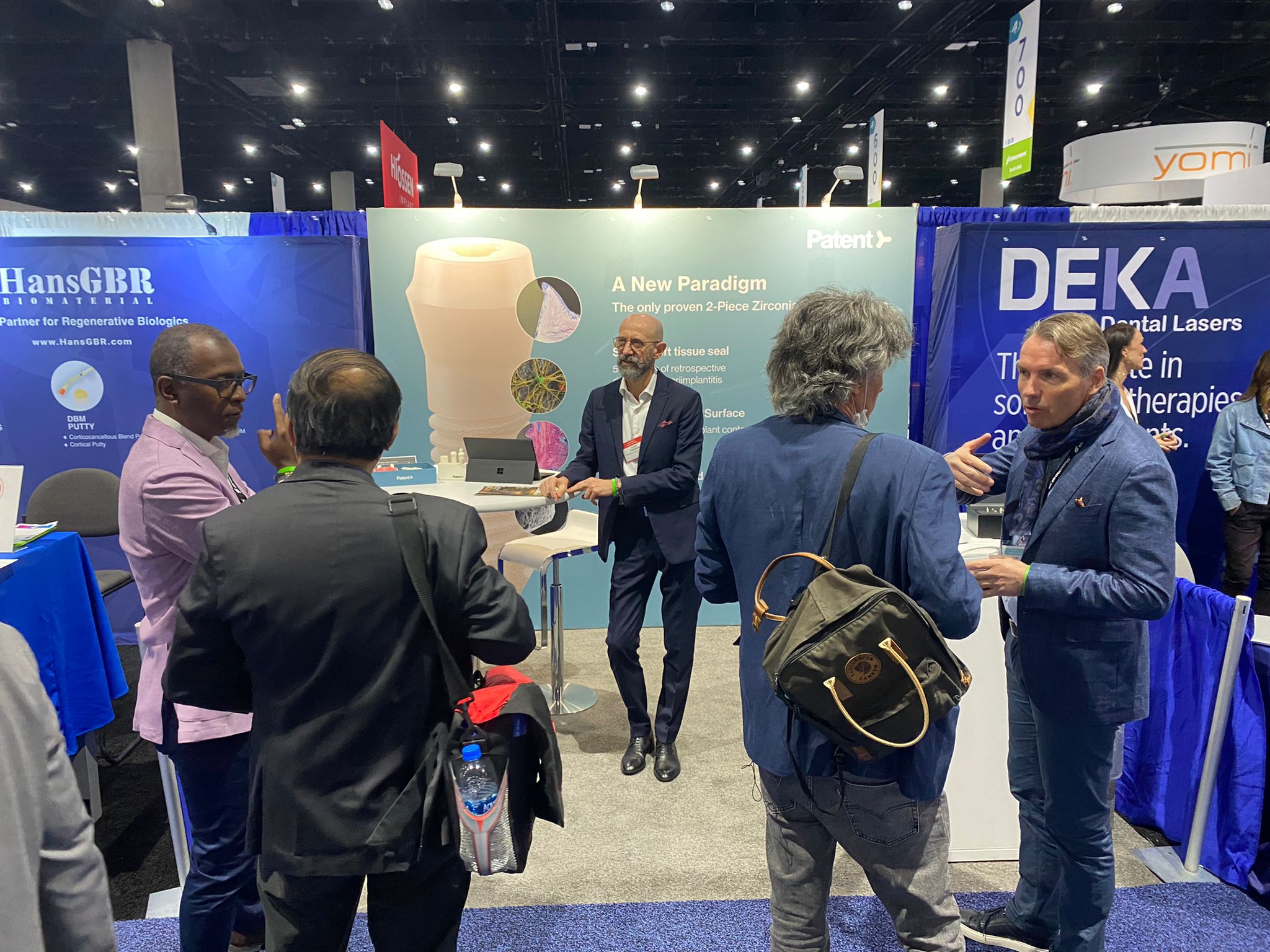
Inflammatory diseases primarily associated with titanium dental implants, such as peri-implantitis, pose major challenges for practitioners today because they compromise the long-term success of implant restorations. Users are embracing zirconia implants as a tissue-friendly and sustainably healthier alternative to metal implants. This ceramic implant material has been proven to reduce peri-implant and systemic long-term complications.
In response to the desire for a broader indication range as well as greater prosthetic flexibility, two-piece zirconia implants are increasingly finding their way onto the market. However, implant dentists are often reluctant to make the switch to two-piece ceramic implants because their clinical application has not been sufficiently documented.
Proving the success of two-piece zirconia implants
A team of researchers at Heinrich-Heine-University Dusseldorf, helmed by Prof. Jürgen Becker, has presented the first-ever reliable long-term data on the clinical success of two-piece zirconia dental implants at the recent Annual Meeting of the Academy of Osseointegration (AO) in San Diego. This unique 9-year retrospective study is making a fundamental contribution to evidence-based implantology and heralding a paradigm shift in the scientific debate around ceramic implant systems. The fact that successful long-term treatments can be realized with the two-piece Patent™ Dental Implant System has now been scientifically proven. Long-term studies in relation to ceramic implants have not yet existed in this form in dental implantology.
The study design
The prospective 9-year study presented at the AO Annual Congress in February under the title "Two-Piece Zirconia Implants in Posterior Regions: A Prospective Cohort Study with a Follow-Up Period of Nine Years” examined patients who had two-piece Patent™ Implants placed between 2011 and 2012 as part of single-tooth restorations in the posterior region and left for transmucosal healing. This long-term study was preceded by a prospective 2-year study with 52 participants, 30 of whom were eligible for inclusion in the 9-year follow-up study. The participants were patients with average health profiles. The implant restorations were performed by surgeons with average skill levels working in the dental department of the University of Dusseldorf. For this reason, among others, the study results have great relevance for daily clinical practice.
The results
For the Patent™ Implants investigated, incredibly high survival rates (95.8%) were documented after a functional period of nine years, which are comparable to that of conventional titanium implants. Also, stable bone and soft tissue levels with a mucosal recession of less than one millimeter were found around all investigated Patent™ Implants after the nine-year functional period. Interestingly, the researchers observed no bleeding on probing (BOP) around more than half of the Patent™ Implants studied.
Furthermore, Prof. Becker emphasizes the excellent esthetics of the examined Patent™ Implants. It should be noted that only one case of implant fracture was documented among the implant systems examined, which the study author attributed to the clinical skill level of the treating implantologist. In view of the convincing results of this unique long-term study, Prof. Becker attests to the unrestricted suitability of the two-piece Patent™ Implant System for use in daily clinical practice and emphasizes that predictable, safe, and reliable long-term restorations can be achieved in average implant patients with the two-piece Patent™ Implant System.
Furthermore, Prof. Becker emphasizes the excellent esthetics of the examined Patent™ Implants. It should be noted that only one case of implant fracture was documented among the implant systems examined, which the study author attributed to the clinical skill level of the treating implantologist. In view of the convincing results of this unique long-term study, Prof. Becker attests to the unrestricted suitability of the two-piece Patent™ Implant System for use in daily clinical practice and emphasizes that predictable, safe, and reliable long-term restorations can be achieved in average implant patients with the two-piece Patent™ Implant System.
A perfectly designed implant system
The excellent long-term clinical performance of the two-piece Patent™ Dental Implant System documented in this first-ever prospective study can be attributed to a number of special design features. Firstly, the Patent™ Implant design was not merely copied from conventional titanium implants but was purposefully engineered with specific material properties of zirconia in mind. The Patent™ Implant design is biomimetic, which means it was modeled on a natural tooth. Thanks to this innovative design, the Patent™ Dental Implant System permits a particularly high degree of soft-tissue adaptation, forming a tight Soft Tissue Seal that prevents pathogenic bacteria from infiltrating the underlying tissues, minimizing the risk of peri-implantitis, marginal bone loss, and systemic complications. Whereas many conventional implant systems feature bacteria-prone micro-gaps inside their screwed internal connections, the Patent™ Dental Implant System features a 100% gap-free prosthetic connection thanks to its revolutionary cemented fiberglass post.
Furthermore, the high survival rates of Patent™ Implants observed in the long-term study can also be attributed to the special implant surface created in a proprietary manufacturing process. The Patent™ surface of the endosteal implant portion is hydrophilic, osteoconductive, and with a roughness value of 6 µm significantly rougher than the surfaces of conventional ceramic implants. Within minutes after insertion, a fibrin network forms on the implant, which promotes rapid and extremely successful bone formation in the sense of contact osteogenesis, particularly optimizing the early phase of healing. The excellent bone healing was also impressively demonstrated in an animal model study (in publication), in which the authors Dr. Roland Glauser and Dr. Peter Schüpbach determined a BIC value of over 70% for Patent™ Implants after only four weeks of healing. With this value, the Patent™ Dental Implant System outperforms all implants investigated in comparable studies to date.
Furthermore, the high survival rates of Patent™ Implants observed in the long-term study can also be attributed to the special implant surface created in a proprietary manufacturing process. The Patent™ surface of the endosteal implant portion is hydrophilic, osteoconductive, and with a roughness value of 6 µm significantly rougher than the surfaces of conventional ceramic implants. Within minutes after insertion, a fibrin network forms on the implant, which promotes rapid and extremely successful bone formation in the sense of contact osteogenesis, particularly optimizing the early phase of healing. The excellent bone healing was also impressively demonstrated in an animal model study (in publication), in which the authors Dr. Roland Glauser and Dr. Peter Schüpbach determined a BIC value of over 70% for Patent™ Implants after only four weeks of healing. With this value, the Patent™ Dental Implant System outperforms all implants investigated in comparable studies to date.
Patent™ users and experts share their experiences
Dr. Sammy Noumbissi, President of the IAOCI (International Academy of Ceramic Implantology), is impressed: "The Patent™ Dental Implant System is the first ceramic implant with pretty much a decade of research behind it. This is unique – especially in the ceramic implant world. In the past, many implant systems have come to the market with comparatively little scientific evidence behind them. The Patent™ Dental Implant System, on the other hand, has been used, tested, and evaluated since 2006. In ceramic implantology, I have never seen a product that has been so extensively researched before it was commercially marketed."
Meanwhile, Swiss implantologist Dr. Roland Glauser confirms, "In the past, I was skeptical about the osseointegration of ceramic implants. Thanks to its special, highly rough surface, even better results in terms of bone healing can be achieved with the Patent™ Dental Implant System than with many titanium implants."
Among the many users of the Patent™ Dental Implant System is also Luxembourg implantologist Prof. Marcel Wainwright. Commenting on the healing success of Patent™ Implants, the ceramic specialist says: "The rougher the surface, the easier it is for the cells to attach to it and form a fibrin network. From all the ceramic implant systems that I have worked with, the Patent™ Dental Implant System has by far the highest roughness." In addition, Prof. Dr. Wainwright values the easy handling of the Patent™ Dental Implant System: "In terms of prosthetics, I can realize everything with it that would be possible in the same way with conventional titanium implant systems. The switch to Patent™ Implants is by no means dramatic – the few things that need to be learned can be explained to interested implantologists in an afternoon."
Meanwhile, Swiss implantologist Dr. Roland Glauser confirms, "In the past, I was skeptical about the osseointegration of ceramic implants. Thanks to its special, highly rough surface, even better results in terms of bone healing can be achieved with the Patent™ Dental Implant System than with many titanium implants."
Among the many users of the Patent™ Dental Implant System is also Luxembourg implantologist Prof. Marcel Wainwright. Commenting on the healing success of Patent™ Implants, the ceramic specialist says: "The rougher the surface, the easier it is for the cells to attach to it and form a fibrin network. From all the ceramic implant systems that I have worked with, the Patent™ Dental Implant System has by far the highest roughness." In addition, Prof. Dr. Wainwright values the easy handling of the Patent™ Dental Implant System: "In terms of prosthetics, I can realize everything with it that would be possible in the same way with conventional titanium implant systems. The switch to Patent™ Implants is by no means dramatic – the few things that need to be learned can be explained to interested implantologists in an afternoon."





